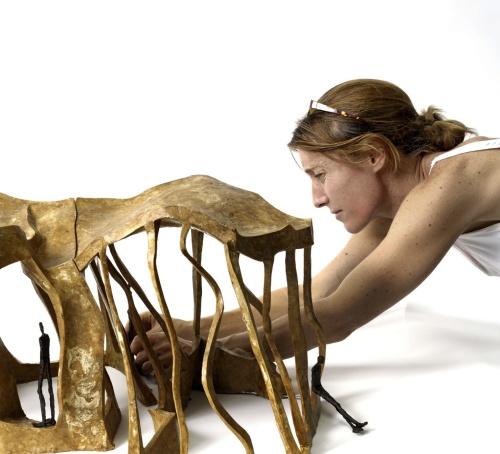When asked about the difference between the artistic categories in calligraphy, Wang explains that one is led by the techniques while the other is lead by heart and soul. Wang has learned the art of calligraphy for more than twenty years; thus, his skills and techniques are the medium for expressing the core values in his heart. In his declaration “The Approach of Building Calligraphy” published in 2013, he shared the spiritual representation of contemporary calligraphy. Coupled with his understandings towards calligraphy, arts, and life, Wang finds the balance between performance and re-presentation in the performing arts of calligraphy, which originates from Japan but is popular among all Asian countries now.
The name of this declaration has deep meanings within each word. “Building” refers to the process of constructing or de-constructing Chinese characters, and the transformation of ancient words to express modern connotations. Painting calligraphy displays the act of creativity, from how to write the words, to how to compose the images. The “approach” emphasizes to search from within, accumulate one’s life experiences to become the artistic inspirations, and then share them with the public. Wang’s calligraphy is built on visual arts and combined with traditional Chinese paintings.
Read more
Artistic Transformation of Contemporary Calligraphy
When asked about the difference between the artistic categories in calligraphy, Wang explains that one is led by the techniques while the other is lead by heart and soul. Wang has learned the art of calligraphy for more than twenty years; thus, his skills and techniques are the medium for expressing the core values in his heart. In his declaration “The Approach of Building Calligraphy” published in 2013, he shared the spiritual representation of contemporary calligraphy. Coupled with his understandings towards calligraphy, arts, and life, Wang finds the balance between performance and re-presentation in the performing arts of calligraphy, which originates from Japan but is popular among all Asian countries now. The name of this declaration has deep meanings within each word. “Building” refers to the process of constructing or de-constructing Chinese characters, and the transformation of ancient words to express modern connotations. Painting calligraphy displays the act of creativity, from how to write the words, to how to compose the images. The “approach” emphasizes to search from within, accumulate one’s life experiences to become the artistic inspirations, and then share them with the public. Wang’s calligraphy is built on visual arts and combined with traditional Chinese paintings. He is particularly skilled at line drawing technique, with which he used golden ink in his past artworks such as “Samsara,” “Be Child,” “Separate the Wheat from the Chaff,” “To Go Far, One Must Start From Near,” “Meaningful,” “Without Overstressing qualifications,” and “Fledge-less.” Golden lines are irregularly arranged, twisted, extended, and diverged. Each piece of artwork is like an individual living organism, with natural beauty and power. In “Hua Fei Hua” collection, Wang applies this sophisticated technique to illustrate the elegance of flowers. Its multi-layer pedals, slender stamens as well as pistils are also delineated. Every line with a style of mannerism resembles a sense, drawing us to fall for it intentionally.
“Hua Fei Hua” collection boasts two stunning features with its application of line drawing technique. The first one is inspired by Wang Bo Cheng’s architectural background. He takes concepts from architectural drawing, which uses lines to form a structure, to add volumes to the conventionally two-dimensional patterns outlined by the line drawing technique. The second feature is drawn from his previous artwork, “In Between,” which explores the spatial composition. The art of calligraphy emphasizes the importance of the blank area. The drawing and the blank area should complement each other, from the structure of the words to the organization of the entire painting. Observing the flowers in “Hua Fei Hua,” one would mistake that petals are filled in with colored ink at first glance. However, when examining more closely, one could see that these petals are in fact the tone of textures. Taking its flat background as the substantial entity, this artwork depicts the flowers with line drawing technique to reflect the depth of the space. The virtual and actual parts in the painting are complementary of one another, which provide a new aspect different from traditionally two-dimensional thinking of line drawing technique.
Another aspect in regards to line drawing that “Hua Fei Hua” addresses is the “changeability” and “concealness” of the lines. Changeability refers to the connection and interaction between the lines. Once the first line is drawn, there is no going back. One stroke connects to another, which presents the relations and tensions between them. It also symbolizes different kinds of relationships human beings have with one another since he was born into this world. As he enters a family, communities, and the society, his relationships with others grow even more complicated. While the network pattern forms from a grid, some leave veins, to a spider web, the desires also grow stronger. To present the works artistically, it seems to be more appealing and expressive to illustrate the true face of lust and ambition. Nonetheless, with the cultivation of Buddhism and calligraphy, Wang is able to view all the desires in life with a calm balance. The desires may always be there. Yet, to transcend beyond those superficial substances is the way to a pure heart.
